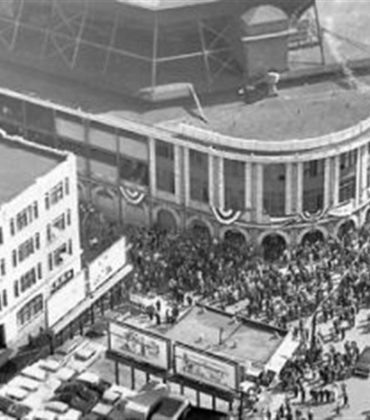The Next Page: Rivers run through us
Just as Pittsburgh has reclaimed its waterfronts from a history of industrial expropriation, now we must embrace a post-industrial way of thinking that idealizes the life of the mind, urges R. TODD ERKEL RIVERS
As kids growing up on Mount Washington, we didn’t need a formal invitation to explore Pittsburgh’s riverfronts. The summons seemed obvious, and we responded with a reckless enthusiasm that came naturally to kids with no money and ample unstructured and unsupervised time. Never mind water conditions (poisoned) or obstacles (barbed wire). We marched, crawled, cut and sometimes rappeled our way down to the water.
If for most Pittsburghers the impulse to approach the water had been dulled by 100 years of industrial expropriation, we failed to notice. Hungry for an experience that quickened our pulse, we were happy to have the place to ourselves.
Twenty years after those adventures, in the early 1990s, I helped co-found a group called Friends of the Riverfront. Our goal was straightforward — to rally money and people around the idea of providing public access to all of the city’s waterfronts.
While the idea of a riverfront greenway and bike/hike path today seems like a no-brainer, not everyone embraced the idea or imagined positive results.
The person who captured the promise of our waterways best was city lover and author Franklin Toker. In a 1988 interview, after the publication of his “Pittsburgh: An Urban Portrait,” he predicted: “Pittsburgh is a very social city, albeit with few places to socialize. Maybe the riverfronts will become that place.”
Dr. Toker got it right. The riverfront trail has supplanted Fifth Avenue, the Cultural District, Point State Park or Grandview Avenue as the city’s de facto Main Street. In so doing, the trail leading from Washington’s Landing to Sandcastle has restored a connection to the region’s center that had begun to fray.
Most measure the new greenway in economic or quality-of-life terms, but I believe the impact runs even deeper. The region’s slow yet steady turn from fretful parochialism toward a more wide-angle view of the world, I believe, owes something to the habit of walking, running and cycling the riverfront. You can’t take to the water without noticing the diversity of people who share and relish this city’s great beauty and potential.
On the 20th anniversary of a simple idea translated into civic action, it’s time to ask: “What next?” How might we apply the Friends of the Riverfront template — successful bottom-up change in a mostly top-down city — in service of continued transformation?
Franklin Toker spoke to one aspect of Pittsburgh’s character — sociability — and how it was trying to emerge. I would add another.
We are a very creative city that somehow still distrusts its creative impulse. If 100 years of industrialization scared us from the riverfront, it also trained us to associate creativity and the arts with leisure or idleness, the antithesis of “Steeltown” ideals.
Here’s a passage from “Pittsburgh: An Urban Portrait”:
“The chief distinction of Pittsburgh is not smoke, and it never was. There has been no major smoke for [60] years, and even when smoke hung thick over the city, for a century it was accepted stoically and almost affectionately as the life-sign of Pittsburgh’s prosperity. Instead, the chief distinction of Pittsburgh is work. As surely as Paris represents glamour, Dallas wealth and Rome the dolce vita, so Pittsburgh stands for industry and production.”
Pride in the city’s history and accomplishments and loyalty to the traditional worker’s creed make it difficult for Pittsburgh to sustain its relevance in the creative/information age.
It’s not just NFL Films (cue the blast-furnace footage) that wants to keep us trapped in time. When I see the region’s working-class young people, it’s not their work ethic that’s holding them back, but their lack of vision. Essayist Richard Rodriguez makes an observation about East Los Angeles youth that could easily apply to Western Pennsylvania:
“I am constantly depressed by the Mexican gang members I meet in East L.A. who essentially live their lives inside five or six blocks. They are caught in some tiny ghetto of the mind that limits them to these five blocks because, they say, ‘I’m Mexican. I live here.’ And I say, ‘What do you mean you live here — five blocks? Your granny, your abuelita, walked 2,000 miles to get here. She violated borders, moved from one language to another, moved from a 16th-century village to a 21st-century city, and you live within five blocks? You don’t know Mexico, man. You have trivialized Mexico. You are a fool about Mexico if you think that Mexico is five blocks. That is not Mexico; that is some crude Americanism you have absorbed.’ ”
In the same way, many Pittsburghers’ blind allegiance to all things “Steeltown,” including its heroic blue-collar work ethic, leaves us hamstrung. Success today hinges at least as much on creativity as drive — a point made most notably by former Carnegie Mellon University professor Richard Florida — but the idea has yet to take root in many of Pittsburgh’s confines.
If a riverfront trail can change our habits of public recreation and social interaction, what would it take to change our understandings of the role of creativity in work and economic prosperity?
Funders and arts groups have been trying to give working-class kids access to creative outlets, but our region has yet to embrace the arts as a life-changing force. It will take a sustained effort, a commitment to the same notion of “continuous access” that we created around the riverfront.
Rather than providing silos for instruction and the expression of talent at such invaluable institutions as Manchester Craftsmen’s Guild and CAPA, we need to disperse more funding, instruction and, above all, celebration of the arts across all our demographic groups and communities — while drawing new audiences toward the city and its arts programming.
The life and work of Pittsburgh playwright August Wilson serves as a beacon for why such a sustained community outreach matters. It’s not just a way to identify the next great American writer, but to change the trajectory of thousands of children’s lives by enhancing their creativity and opening their minds, regardless of their ultimate career tracks or professions.
It’s time we see cultural titans like August Wilson as being every bit as heroic as Joe Magarac, the idealized steelworker of legend. Such a shift in perspective would allow Pittsburgh to step more fully into 21st-century global society, retaining the most relevant aspects of our past while empowering our young people to fashion their own distinct future.
Pittsburgh superheroes, then and now
Joe Magarac was an imaginary folk hero from Pittsburgh who was to steelmaking what Paul Bunyan was to timber. Steelmaking and other manufacturing remains important to Pittsburgh, and hard work remains highly valued, but we wondered what a modern-day Joe Magarac might look like, a folk hero who represents other types of workers the region will need to thrive in the 21st century.
So please let us tell you about Joe Magarac — and introduce you to Adisa O’Leary.
Joe was of eastern European stock and worked in the steel mills of Pittsburgh. His physical power and his courageous, giving and industrious character made Joe the greatest steelworker who ever lived.
In fact, Joe was made of steel, born in an iron mine and raised in a furnace. Some versions of his story said Joe was 7 feet tall. Others claimed he was as tall as a smokestack! He ate hot steel like soup and cold ingots like meat.
Mighty Joe could do the work of 29 men because he never slept, working 24 hours a day, 365 days a year. He stirred vats of hot steel with his bare hands. He made train rails by squeezing molten steel between his fingers.
Joe was generous, self-sacrificing and brave. Once, for example, he won a weight-lifting contest and the prize was marrying the mill boss’ daughter Mary. But Mary was in love with Pete Pussick. Instead of claiming his prize, Joe stepped aside so she could marry her true love.
Joe regularly saved steelworkers from danger. When a crane holding a ladle with 50 tons of molten steel broke above his crew, he caught it with his bare hands. A whole train of ingot-buggies broke loose and headed full steam downhill toward a group of workers. In the nick of time, Joe caught the last buggy and pulled the train back up the hill, saving everyone!
No one is sure what happened to Joe. In one version of his story, he jumped into a Bessemer converter to save a load of steel and lives on in the girders of a building or bridge. Another version claims he is still alive, waiting in an abandoned mill for the day that the furnace burns again.
Adisa is “Cabalasian,” like Tiger Woods — part Caucasian, part black, part Asian. She speaks seven languages, led the Pitt women’s volleyball team to a national championship and employs her Ph.D. in microbiology to cure disease and create renowned works of art based on the structure, movement and chemical make-up of microorganisms.
Adisa was born in the Garfield neighborhood of Pittsburgh, emerging in molten glass from the furnace of the Pittsburgh Glass Center (her name means “one who is clear” in the Yoruba language of Africa) and shaped by the hands and imagination of a 14-year-old girl. Adisa came to life upon her graduation from Pittsburgh’s Neighborhood Academy and acceptance into London’s Royal Academy of Art.
Brilliant and loving, Adisa travels the world on gossamer wings, dropping in on collaborators to find cures for cancer, heart disease and the common cold. Along the way, she gathers the latest medical research to inform her paintings, sculptures and collages; mentors young children in science and the arts, and plays pickup games of volleyball. She is credited with saving millions of lives, not only by conquering diseases but also by firing the imaginations of young people so that they, too, can lead economically rewarding lives of purpose and joy.
Adisa is fabulously wealthy, earning millions from the patents she owns and the artwork she sells, but she gives hardly a thought to herself. She lives in an efficiency apartment, buys her clothes at thrift stores, grows her own food in a backyard garden and gives virtually all of her money to charity.
It is said that after Adisa dies, her spirit again will inhabit an endearing work of art crafted by the hands of a child, and she will come to life once again.
The Joe Magarac story is adapted from the website of the Johnstown Area Heritage Association (www.jaha.org).
The story of Adisa O’Leary is by Greg Victor, oped/Forum editor of the Post-Gazette (gvictor@post-gazette.com).
First Published July 25, 2010,















